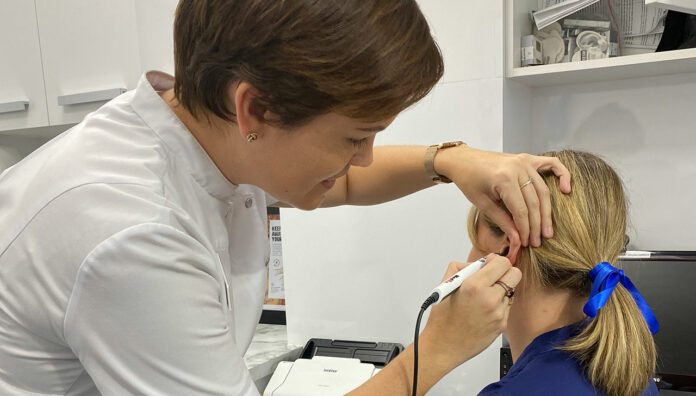
Ear disease in rural and remote communities is occurring at alarmingly high rates, with limited access to health services a significant contributing factor.
To address the issue, remote pharmacy academic Selina Taylor MPS devised LISTEN UP (Locally Integrated Screening and Testing Ear aNd aUral Program) for her PhD project through James Cook University.
The community pharmacy-based initiative, which was piloted in north-west and central-west Queensland pharmacies, trained pharmacists to conduct ear examinations on patients with ear complaints using video otoscopy and tympanometry.
Pharmacists were then able to make recommendations including no treatment, pharmacy-only products, or GP referral through a direct pathway.
Reducing pressure on the healthcare system
The project began with research into pharmacist, patient and health professional perspectives of expanded pharmacy services in rural and remote settings, which Dr Taylor said was positive across the board.
‘Patients wanted increased accessibility, pharmacists felt as though they should and could do more, and health professionals were also supportive, given that a lot of these regions [are short staffed],’ she said.
Pharmacists regularly had patients coming through with ‘blocked ear’ and ‘ear pain’ complaints, but they were unable to make a definitive diagnosis on a symptomatic description, and had a limited range of over-the-counter products to offer.
As a result, many patients presented to emergency departments (EDs) with ear complaints that could have been managed in community pharmacies.
By examining a patient’s ear canals and given a referral pathway to GPs, participating pharmacists could redirect patients away from EDs and into same- or next-day GP appointments.
‘Young mums described how great it was not having to take their child to ED and wait 6 hours to be seen.’
Selina Taylor MPS
‘It was [also] time saving for GPs, who were able to provide telehealth consults quite quickly after the pharmacist examination,’ Dr Taylor said.
‘They could make diagnoses and prescribe as required without having to bring patients into the practice.’
One otolaryngologist said that access to the video otoscope images saved his patients a 2,000–kilometre round trip for a 3-minute appointment.
Positive patient outcomes
From a patient perspective, the pilot provided convenience and improved knowledge about ear health.
‘Some people were travelling 600 kilometres, or waiting 2–4 weeks to see their GP,’ Dr Taylor said.
‘Young mums described how great it was not having to take their child to ED and wait 6 hours to be seen.’
For many, the visual aspect of the service improved their understanding of their ear condition.
‘Using video otoscopes meant patients could see inside the ear canal during their consultation,’ Dr Taylor said.
‘Some people said they have had ear disease for a number of years, and they’ve never been able to see inside their ear canal for themselves.’
Glory-Anne Leaupepe, a professional services pharmacist at Pharmacy First in Mount Isa, got involved in the project to address ear-health issues in her local community.
‘We see a lot of middle ear infections up here,’ she said. ‘It’s pretty hard to get into a GP, and even more frustrating to go to hospitals.’
Through the pilot, Pharmacy First helped 50 patients with their ear complaints. Ms Leaupepe said it was a useful educational tool which prevented patients from using the wrong medicine.
‘[Patients] would come in requesting ear wax drops because they felt blocked up, and then we’d have a look inside their ears and see they were perfectly clean,’ she said.
‘We also let them know that they don’t need antibiotics straightaway, and that you can [often] treat an acute inner ear infection with analgesia.’
Other patients were saved from a long wait to see their GP.
‘Patients would come in, asking if there’s anything they can do because they can’t get into the doctor’s [clinic],’ Ms Leaupepe said.
‘By looking inside the ear canal, we could say, “It doesn’t look like you have otitis media, all you need is pain relief for the next couple of days. It doesn’t improve, then you should see your GP”.
‘But a lot of the time, it does resolve.’
Collaboration essential in rural and remote communities
All the health providers in rural and remote communities need to work together to provide the best care for patients, Dr Taylor told Australian Pharmacist.
‘Everyone’s strapped, so having that continuity of care from a pharmacist into a GP practice was critical for this service,’ she said.
‘We can identify a problem, but without having a pathway to follow, there’s nowhere for patients to go.’
Looking forward, Dr Taylor said pharmacists will continue to expand their range of services to meet the specific health needs of their local communities. But it is essential that these services are funded and remunerated.
Costs of providing the ear health service include training, pharmacist time, locum backfill and accomodation, and $10,000 worth of equipment per pharmacy.
While training and equipment costs were covered during the pilot, pharmacists had to provide consultations in their own time, which could take anywhere from 10–50 minutes.
‘That was one of the barriers [to uptake], Ms Taylor said. ‘If they were short on staff or busy with other pharmacy tasks, providing the service was less of a priority. That’s why we need funding.’



 Professor Margie Danchin[/caption]
Professor Margie Danchin[/caption]

 Dr Peter Tenni[/caption]
Dr Peter Tenni[/caption]
 How should we deprescribe gabapentinoids, according to the Maudsley Deprescribing Guidelines[/caption]
How should we deprescribe gabapentinoids, according to the Maudsley Deprescribing Guidelines[/caption]



 Pharmacists have always prescribed, but they have the potential to prescribe much more
Pharmacists have always prescribed, but they have the potential to prescribe much more



